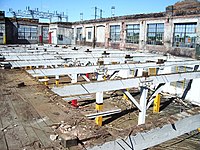
Back تفكيك (مباني) Arabic Рециклиране на строителни отпадъци Bulgarian تخریب (ساختمان) Persian Lajitteleva purkaminen Finnish Déconstruction (BTP) French 해체 Korean Lerai Malay வீழ்கட்டமைப்பு (கட்டிடம்) Tamil
This article possibly contains original research. (September 2020) |
This article may need to be rewritten to comply with Wikipedia's quality standards. (September 2022) |

In the context of physical construction, deconstruction is the selective dismantlement of building components, specifically for reuse, repurposing, recycling, and waste management. It differs from demolition where a site is cleared of its building by the most expedient means. Deconstruction has also been defined as "construction in reverse". Deconstruction requires a substantially higher degree of hands-on labor than does traditional demolition, but as such provides a viable platform for unskilled or unemployed workers to receive job skills training.[1] The process of dismantling structures is an ancient activity that has been revived by the growing fields of sustainable and green building.[2]
When buildings reach the end of their useful life, they are typically demolished and hauled to landfills. Building implosions or ‘wrecking-ball’ style demolitions are relatively inexpensive and offer a quick method of clearing sites for new structures. On the other hand, these methods create substantial amounts of waste. Components within old buildings may still be valuable, sometimes more valuable than at the time the building was constructed. Deconstruction is a method of harvesting what is commonly considered “waste” and reclaiming it into useful building material. Most modern buildings are difficult to deconstruct due to the designs of such buildings.[3]
- ^ "A Report on the Feasibility of Deconstruction: an investigation of deconstruction activity in four cities" (PDF). HUD.
- ^ "Taisei Corporation's Tecorep reducing CO2 emissions by 85%". Archived from the original on 2016-04-15. Retrieved 2017-08-26.
- ^ Kanters, Jouri (November 27, 2018). "Design for Deconstruction in the Design Process: State of the Art". Buildings. 8 (11): 150. doi:10.3390/buildings8110150.
© MMXXIII Rich X Search. We shall prevail. All rights reserved. Rich X Search